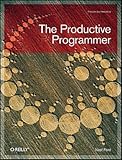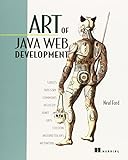Neal Ford
Director / Software Architect / Meme Wrangler
Neal is Director, Software Architect, and Meme Wrangler at ThoughtWorks, a global IT consultancy with an exclusive focus on end-to-end software development and delivery.Before joining ThoughtWorks, Neal was the Chief Technology Officer at The DSW Group, Ltd., a nationally recognized training and development firm. Neal has a degree in Computer Science from Georgia State University specializing in languages and compilers and a minor in mathematics specializing in statistical analysis.
He is also the designer and developer of applications, instructional materials, magazine articles, video presentations, and author of 6 books, including the most recent The Productive Programmer. His language proficiencies include Java, C#/.NET, Ruby, Groovy, functional languages, Scheme, Object Pascal, C++, and C. His primary consulting focus is the design and construction of large-scale enterprise applications. Neal has taught on-site classes nationally and internationally to all phases of the military and to many Fortune 500 companies. He is also an internationally acclaimed speaker, having spoken at over 100 developer conferences worldwide, delivering more than 600 talks. If you have an insatiable curiosity about Neal, visit his web site at http://www.nealford.com. He welcomes feedback and can be reached at nford@thoughtworks.com.
Presentations
Building Evolutionary Architectures
8:30 AM MDT
An evolutionary architecture supports incremental, guided change along multiple dimensions.
For many years, software architecture was described as the “parts that are hard to change later”. But then microservices showed that if architects build evolvability into the architecture, change becomes easier. This talk, based on my upcoming book, investigates the family of software architectures that support evolutionary change, along with how to build evolvable systems. Understanding how to evolve architecture requires understanding how architectural dimensions interact; I describe how to achieve appropriate coupling between components and services. Incremental change is critical for the mechanics of evolution; I cover how to build engineering and DevOps practices to support continuous change. Uncontrolled evolution leads to undesirable side effects; I cover how fitness functions build protective, testable scaffolding around critical parts to guide the architecture as it evolves.
The software development ecosystem exists in a state of dynamic equilibrium, where any new tool, framework, or technique leads to disruption and the establishment of a new equilibrium. Predictability is impossible when the foundation architects plan against changes constantly in unexpected ways. Instead, prefer evolvability over predictability. This keynote illustrates how to achieve evolutionary architectures and how to retrofit existing systems to support better evolution.
Restructuring & Migrating Architectures
10:30 AM MDT
Patterns/antipatterns, techniques, engineering practices, and other details showing how to restructure existing architectures and migrate from one architecture style to another.
A common challenge facing many architects today involves restructuring their current architecture or migrating from one architectural style to another. For example, many companies start with monolithic applications for simplicity, but find they must migrate it to another architecture to achieve different architectural characteristics. This session shows patterns/antipatterns, techniques, engineering practices, and other details showing how to make major changes to architectures. This session introduces a new measure, the architectural quantum, as a way of measuring and analyzing coupling and portability within architectures.
Building Evolutionary Architectures: Architectural Fitness Function Katas
1:00 PM MDT
Building Evolutionary Architectures requires identifying and creating architectural fitness functions. This hands-on workshop defines fitness functions and provides group exercises to help identify and discover them.
According to the Building Evolutionary Architectures book, an architectural fitness function provides an objective integrity assessment of some architectural characteristic(s). This hands-on workshop provides examples of fitness functions and group exercises to identify, define, and implement a variety of fitness functions: atomic, holistic, continuous, triggered, temporal, and others.
Architecture Foundations: Styles & Patterns
2:45 PM MDT
This session covers basic application and distributed architectural styles, analyzed along several dimensions (type of partitioning, families of architectural characteristics, and so on).
A key building block for burgeoning software architects is understanding and applying software architecture styles and patterns. This session covers basic application and distributed architectural styles, analyzed along several dimensions (type of partitioning, families of architectural characteristics, and so on). It also provides attendees with understanding and criteria to judge the applicability of a problem domain to an architectural style.
Architecture Foundations: Characteristics & Tradeoffs
4:30 PM MDT
This session describes how architects can identify architectural characteristics from a variety of sources, how to distinguish architectural characteristics from domain requirements, and how to build protection mechanisms around key characteristics. This session also describe a variety of tradeoff analysis techniques for architects, to try to best balance all the competing concerns on software projects.
Architects must translate domain requirements, external constraints, speculative popularity, and a host of other factors to determine the key characteristics of a software system: performance, scale, elasticity, and so on. Yet architects must also analyze the tradeoffs each characteristics entails, arriving at a design that manages to maximize as many beneficial properties as possible. This session describes how architects can identify architectural characteristics from a variety of sources, how to distinguish architectural characteristics from domain requirements, and how to build protection mechanisms around key characteristics. This session also describe a variety of tradeoff analysis techniques for architects, to try to best balance all the competing concerns on software projects.
Stories Every Developer Should Know
8:30 PM MDT
Stories and lessons from architecture, design, process, and other sources, each illustrating important principles and pitfalls for modern architects.
Those who cannot remember the past are condemned to repeat it. –George Santayana
The past is never dead. It's not even past. –William Faulkner
Most developers pursue the Latest and Greatest with intense fervor, yet the history of engineering, including software projects, contains rich lessons that we risk repeating ad nauseam. This session recounts a variety of stories of projects that failed architecturally…and why. Ranging from the Vasa in 1628 to Knight Capital in 2012, each story tells of a mistaken interpretation of some architectural fundamental principle and the consequences–some good, some less so. I I also look at the common threads for these stories, which resonates with problems many companies have but don't realize.
- Pets. Com
- San Francisco project
- The Vasa
- F16
- Sagrada Familia
- Tacoma Narrows Bridge
null- Ada
- Serialization
- Knight Capital
- Ariane 5
- Webvan
- Chandler project
Build Your Own Technology Radar Workshop for Architects
9:00 AM MDT
A Technology Radar is a tool that forces you to organize and think about near term future technology decisions, both for you and your company. This talk discusses using the radar for personal breadth development, architectural guidance, and governance.
ThoughtWorks Technical Advisory Board creates a “technology radar” twice a year, a working document that helps the company make decisions about interesting technologies and where we spend our time. ThoughtWorks then started conducting radar-building exercises for our clients, which provides a great medium for technologists company-wide to express their opinions about the technologies they use every day. For companies, creating a radar helps you document your technology decisions in a standard format, evaluate technology decisions in an actionable way, and create cross-silo discussions about suitable technology choices. This session describes the radar visualization and how to conduct a radar building session for yourself. After a brief introduction, the bulk of the workshop consists of attendees building a radar for the group, following the same procedure you'll use when you do this exercise at your company. At the end, we'll have created a unique Radar for this event and practiced doing it for yourself.
Automating Architecture Governance
11:00 AM MDT
This session describes mechanisms to automate architectural governance at application, integration, and enterprise levels
A nagging problem for architects is the ability to enforce the governance policies they create. Yet, outside of architecture review boards or code reviews, how can architects be sure that developers utilize their rules? This session describes mechanisms to automate architectural governance at application, integration, and enterprise levels. By focusing on fitness functions, architects define objective tests, metrics, and other criteria to ensure governance polices stick.
Books
The Productive Programmer (Theory in Practice (O'Reilly))
by Neal Ford
Anyone who develops software for a living needs a proven way to produce it better, faster, and cheaper. The Productive Programmer offers critical timesaving and productivity tools that you can adopt right away, no matter what platform you use. Master developer Neal Ford not only offers advice on the mechanics of productivity--how to work smarter, spurn interruptions, get the most out your computer, and avoid repetition--he also details valuable practices that will help you elude common traps, improve your code, and become more valuable to your team. You'll learn to:- Write the test before you write the code
- Manage the lifecycle of your objects fastidiously
- Build only what you need now, not what you might need later
- Apply ancient philosophies to software development
- Question authority, rather than blindly adhere to standards
- Make hard things easier and impossible things possible through meta-programming
- Be sure all code within a method is at the same level of abstraction
- Pick the right editor and assemble the best tools for the job
This isn't theory, but the fruits of Ford's real-world experience as an Application Architect at the global IT consultancy ThoughtWorks. Whether you're a beginner or a pro with years of experience, you'll improve your work and your career with the simple and straightforward principles in The Productive Programmer.
The ThoughtWorks Anthology: Essays on Software Technology and Innovation (Pragmatic Programmers)
by ThoughtWorks Inc.
ThoughtWorks is a well-known global consulting firm; ThoughtWorkers are leaders in areas of design, architecture, SOA, testing, and agile methodologies. This collection of essays brings together contributions from well-known ThoughtWorkers such as Martin Fowler, along with other authors you may not know yet. While ThoughtWorks is perhaps best known for their work in the Agile community, this anthology confronts issues throughout the software development life cycle. From technology issues that transcend methodology, to issues of realizing business value from applications, you'll find it here.
No Fluff, Just Stuff Anthology: The 2006 Edition (Pragmatic Programmers)
by
Twenty-seven weekends a year, the No Fluff, Just Stuff conference rolls into another town, featuring the world's best technical speakers and writers. Up until now, you had to go to one of the shows to soak up their collective wisdom. Now, you can hold it in the palm of your hand. The No Fluff, Just Stuff Anthology represents topics presented on the tour, written by the speakers who created it. This book allows the authors the chance to go more in depth on the subjects for which they are passionate. It is guaranteed to surprise, enlighten, and broaden your understanding of the technical world in which you live.
The No Fluff, Just Stuff Symposium Series is a traveling conference series for software developers visiting 27 cities a year. No Fluff has put on over 75 symposia throughout the U.S. and Canada, with more than 12,000 attendees so far. Its success has been a result of focusing on high quality technical presentations, great speakers, and no marketing hype. Now this world-class material is available to you in print for the first time.




